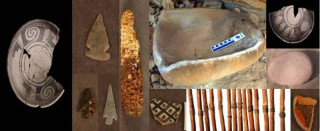Range Creek Artifacts
The field station acts as an outdoor laboratory preserving a record of how people left objects behind. To preserve this record, very few objects are collected from the ground surface when sites are recorded. If an artifact is collected by archaeologists in Range Creek, it is because it is extremely rare, fragile, or it is diagnostic in some way. Diagnostic artifacts are those with stylistic characteristics that tell us when and by whom they were made (relative dating), or those artifacts that can be radio carbon dated (absolute dating). The range of dates associated with particular artifacts is based on data collected from many archaeological sites and used to build relative chronologies. Absolute dates on artifacts made from organic materials come from radiocarbon dates, which give researches a calendar year for when the plant or animal lived. Radiocarbon dates from organic samples submitted for analysis indicate a major occupation in the canyon at approximately 1050 CE. During excavation, all artifacts recovered are collected and curated at the Natural History Museum of Utah.
Artifacts found in Range Creek Canyon date primarily to the Fremont Archaeological Complex (300 - 1350 CE). Range Creek collections include: pottery, stone tools, bone artifacts, and plant remains (corn, digging sticks, arrows, snares, etc.). Sediment collected during excavation can tell us about past human diets with pollen, macrofossil remains, and starch.
Some of the important questions about any people are when were they here? How long were they here? What did they do while they were here? Artifacts can help archaeologist answer these questions. This is just one reason that it is important that visitors to archaeological sites leave artifacts where they find them. When someone takes an arrow point or piece of pottery from a site, they take something far more valuable than the object. They rob the site of the most important information of all - the answers to questions about past human's behavior.
